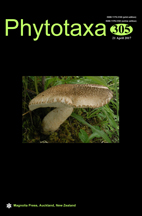Abstract
Laboulbeniales are well known ectoparasites of insects. Among arachnids they were only known parasitizing mites. A new genus of Laboulbeniales, with one species, Opilionomyces dicranolasmatis, is described for fungi parasitizing Dicranolasma harvestmen (Opiliones) collected in Turkey and Greece. The new genus is characterized by the uniseriate receptacle divided into two parts, below the perithecium as a pedicel and above as a row of cells adnate and following the dorsal side of perithecium. The three upper tiers of wall cells are equal in height but shorter than the lower tier. The new genus is accommodated in the subfamily Laboulbenioideae. Similarly to some other Laboulbeniales found on insects and millipedes, Opilionomyces shows site specificity, and we relate its restricted distribution on the pedipalps and chelicerae of the harvestmen to sexual transmission of the fungus. Although both Acari and Opiliones belong to the Arachnida subphylum within arthropods, the Laboulbeniales parasitizing the two orders show no morphological evidence of being closely related.

